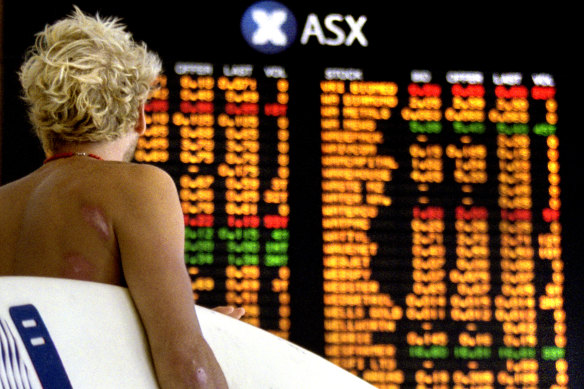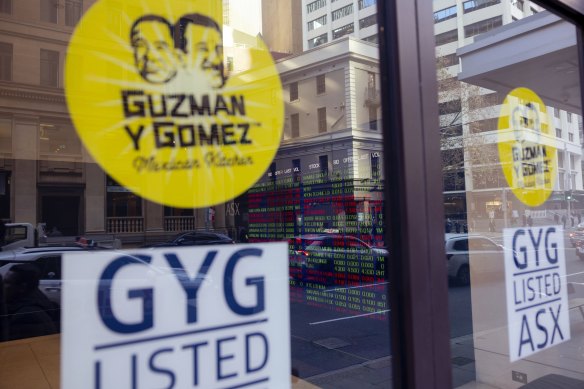Opinion
Why we need to make the ASX great again
William Bennett
Money contributorI’m a big MAGA guy. Huge. I mean, who wouldn’t want to Make the ASX Great Again?
It’s no secret that the number of companies on the ASX is shrinking faster than your average packet of Tim Tams. In the past financial year, three times more companies delisted from the ASX than made an initial public offering (IPO).

Investors, especially the young, are leaving in droves.Credit: Tanya Lake
Altium, Boral and CSR are just a few of the great Australian companies we’ve lost this year, and arguably our greatest tech success, Canva, intends to list in the US next year, following the lead of Atlassian in 2015.
Investors, especially the young, are leaving in droves. Data from brokerage platform eToro shows the 10 most widely held stocks by Australian investors are all US listed.
It’s estimated that by the year’s end, international shares could account for a combined 70 per cent of Gen Z and Millennial portfolios, with just 30 per cent allocated to Australian shares.
Many of my fellow day traders have given up on the ASX entirely and moved to exclusively trading US markets (much to the detriment of their sleep hygiene).
This exodus from the national stock exchange would all be very un-Australian if it weren’t so justifiable.
US tech growth stocks, the “magnificent seven”, are the reasons for the significant outperformance of the US markets compared with ours, which is about as impressive on the world stage as our national breakdancing team.
The problem isn’t globalisation (London is in the same boat in struggling to expand its sharemarket) – it’s Americanisation. The US dominates more than 60 per cent of the global sharemarkets – an increase of about 20 per cent since 2008.
Cambridge-founded chipmaker Arm and Germany’s Birkenstock are the most recent home-grown success stories to snub their national exchanges for the premium and prestige of listing in New York.
However, it doesn’t seem unreasonable that major companies founded in Australia should still call Australia home and list locally. It just requires concerted effort.
The recent success of Guzman y Gomez, might tempt prospective IPOs away from the private markets, where all the fun is being had, but there remains a task to convince prospective IPOs who are considering US listings to stay on the home team.
The ASX says there is “no shortage of demand” from companies mulling floats. However, like a mirage, this demand seems to move further away the closer we get. But with the rate-cutting cycle under way, increased certainty on the economic front means this time might be different.
“As a capital markets system, we need to do more work on selling the advantages of listing on the ASX over other exchanges,” says James Posnett, head of listings at the ASX. “There is an opportunity for us to do more and target the companies that don’t meet the threshold for the S&P 500 to list here instead.”
There is no shortage of successful Australian companies that asset managers and retail investors would jump at the opportunity to buy, and thanks to our superannuation system, there is no shortage of institutional capital looking for places to deploy its cash.

Guzman y Gomez floated on the ASX in in June. Credit: Dominic Lorrimer
“An IPO is only tapping into the market once. The ability to raise further funds quickly and easily once listed is very appealing if a company’s wishing to pursue expansion and growth opportunities,” points out Posnett.
Tom Cowan, of TDM Growth Partners, the firm that brought Guzman y Gomez to the public markets, is also a true patriot. “History would suggest that the ASX is a wonderful place to list fast-growing businesses, and while there is always an enticing aspect to the US, the benefits of a local ASX listing far outweighs this,” says Cowan.
The co-founders of Atlassian, which listed in the US in 2015, cited the size and maturity of the US markets as the main reasons the company listed offshore instead of in Australia.
Cowan points to a range of perceived advantages to listing on the ASX over the US exchanges, such as a potential valuation premium, relatively greater media coverage, lower costs, a faster listing process and what he calls the opportunity to “be a big fish in a small pond”.
A vibrant and expanding public capital market is the foundation of a good Western democracy.
If Canva chose to list on the ASX, it would immediately take the title of Australia’s largest technology company and fill the hearts of Australian investors with pride, and in doing so, would no doubt inspire others to follow.
However, money talks, and Canva’s valuation is too high, its liquidity needs too great, and the investor base for tech stocks in the US is more sophisticated. Quoting shares in US dollars instead of Australian makes it much easier to attract talent with equity.
But there are a few tweaks that could make the ASX more attractive. The reality is that we can’t compete with America’s tech dominance. We should be playing to our strengths in mining and healthcare and rebuild out the lost utilities sector for those juicy dividends.
A quick whip-round of my industry contacts produced an IPO Christmas list of iconic Australian companies investors would jump at, including Bunnings, Kmart, Cotton On, Visy, Hancock Prospecting, Snowy Hydro and Sydney Metro.
”The retail investors and the liquidity you get from a listed stock is incredibly powerful, and there’s still a deep pool of capital available for that,” David Di Pilla, managing director of HMC Capital, told The Australian Financial Review.
The London Stock Exchange is facing a similar shrinkage problem. In the past 20 years, UK-listed equities have gone from accounting for 11 per cent of the global equity market to less than 4 per cent (Australia’s is 2 per cent).
The British financial regulator has been tinkering with regulations including introducing dual-class structures, where founders’ shares represent greater voting power, in an attempt to lure back companies as there has been a significant increase in the number and proportion of IPOs that feature a dual-class shares structure.
Australia’s is one of the few markets which ban dual-class listings; perhaps it’s a manifestation of our iconic tall-poppy syndrome, shunning the entrepreneurship of the founder-led business.
“We know we’re an outlier globally in not permitting dual-class listings, and it is something we could consider in close consultation with ASIC and the market,” says Posnett.

Canva is a high-profile example of an Australian company choosing to list internationally.
Of course, there is always the opportunity to cut more red tape and make listing cheaper and even faster. The social credibility and eclat of being public needs to outweigh the burden of the extra paperwork and governance requirements.
The chairman of Harvey Norman is the latest in a string of founders to bemoan some of the disproportionate requirements and red tape required by the ASX to remain listed.
Indeed, it seems unreasonable that a small-cap company has the same financial reporting obligations as BHP, despite having a fraction of the market cap and resources.
Additionally, according to Cowan, the process by which “insiders” can trade in Australia is flawed, and it allows insiders to trade only within specified windows which “creates adverse market dynamics and perverse incentives for all participants,” says Cowan.
”There is a very easy solve here: ASIC allowing for transparent, written trading plans that articulate a predetermined, scheduled and automated basis when buying and selling will occur, such as the Americans do, would be a meaningful change.“
A vibrant and expanding public capital market is the foundation of a good Western democracy, so let’s back ourselves and make the ASX great again, starting with getting Australian made Australian listed.
The Market Recap newsletter is a wrap of the day’s trading. Get it each weekday afternoon.